Tsog dates 2023: Happy Dakini Day — Introducing the Wisdom of the Female Enlightened Dakinis
Dakini Day, celebrated on the 25th day of each lunar month in Vajrayana Buddhist traditions, celebrates the feminine energy of wisdom. (DATES FOR 2023 Tsog updated below.)
Devoted Buddhists will celebrate with a Tsok (Tsog), a feast including food, singing, a group (or single) sadhana full of sound and celebration. The 10th is also celebrated with Daka Tsog to honor Guru Rinpoche and the Heroes (Dakas). Tsog is normally a commitment in higher yogic practices.
For a full story on “What is Tsog” see this feature>>
-
Dakinis are portrayed as elusive, playful and often fierce and naked to symbolically convey how elusive true Wisdom encompassing “Emptiness” can be.

Dakini Tsog Days 2023
Important: Dakini day is Mother Tantra Tsog, on the 25th of the Lunar month.
- January 17, 2023: ANNUAL VAJRAYOGINI DAY and Dakini Tsog celebrating Vajrayogini, Tara and all the Dakinis honored on Lunar Month 11, 25th Day (special to Vajrayogini).
- February 15, 2023: Lunar Month 12, 25th day, Year of Tiger, 2149
- March 17, 2023: Lunar Month 1, 25th day, Water Rabbit Year 2150
- April 15, 2023: Lunar Month 2, 25th day, Water Rabbit Year 2150
- May 14, 2023: Lunar Month 3, 25th day, Water Rabbit Year 2150
- June 13, 2023: Lunar Month 4, 25th day, Water Rabbit Year 2150
- July 12, 2023: Lunar Month 5, 25th day, Water Rabbit Year 2150
- August 11, 2023: Lunar Month 6, 25th day, Water Rabbit Year 2150
- September 9, 2023: Lunar Month 7, 25th day, Water Rabbit Year 2150
- October 9, 2023: Lunar Month 8, 25th day, Water Rabbit Year 2150
- November 7, 2023: Lunar Month 9, 25th day, Water Rabbit Year 2150
- December 7, 2023: Lunar Month 10, 25th day, Water Rabbit Year 2150
Dakinis: Protective, Mother, Activity, Wisdom
Without contradiction to their role as exemplars of Emptiness, Dakinis can also represent fierce activities (Lion-Faced Dakini, aspects of Tara), and protection (Green Tara and Palden Lhamo) — the ferocious protective love of a mother [For a story on Palden Lhamo, the female protector, view here>>]. Most Tibetan Buddhist temples and meditation centres try to arrange a monthly Tsog on this day each month, with celebrants bringing food as offerings. It is always a happy day, that invites blessings not only for the attendees, but for all sentient beings.
Padmasambhava described Dakinis as “the bestower of excellent blessings.” [3]
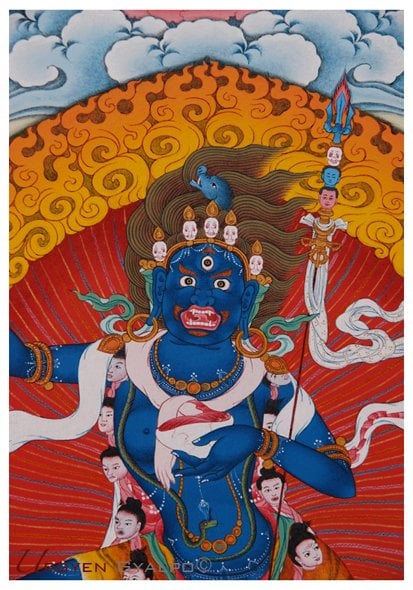
What is a Dakini?
The Dakini represents the divine feminine. (Khandroma in Tibetan, K’ung-hsing fo-mu in Chinese.) Dakini practices focus on Enlightened Feminine (although there are also some “unenlightened Dakinis”) — the Enlightened Dakinis such as Vajrayogini or Vajravarahi and, of course, Tara in all her forms. Dakini can also refer to female sangha, teachers and students who might be exemplars of the path.
In Buddhism, typically, the male Buddhas represent compassionate means, epitomized in Avaolokiteshvara (Chenrezig), while the female Buddhas represent Wisdom, typically exemplified in Tara or Vajrayogini. The symbols of bell and vajra (Ghanta and Dorje) represent female wisdom — the bell, which makes the sound of “Emptiness” — and the Vajra, representing compassionate means.
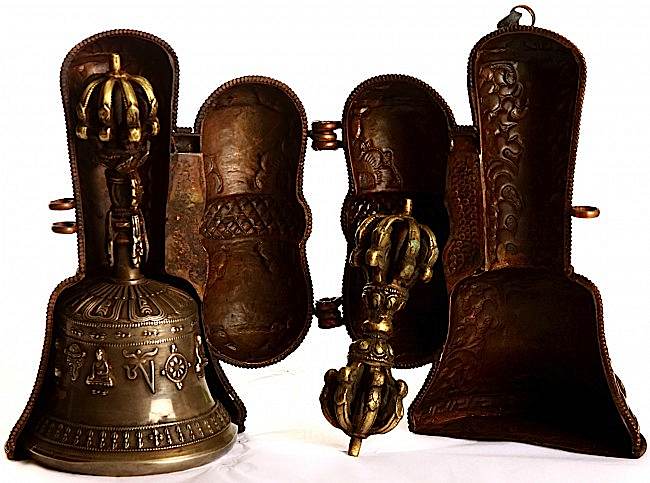
The Dakini is almost always an advanced practice, or Highest Yoga Tantra, largely because their practice explores the challenging notion of “Emptiness” (not be be confused with Nothingness. (For an article on Emptiness, see>>)
Padmasambhava, the great Eight Century Enlightened Yogi of Tibet, “reasoned that women are better equipped to realize the wisdom of the teachings…” [1]
Playful, Naked and Elusive
Just as true wisdom is “elusive”, the female enlightened, in the form of Dakinis, is very “elusive and playful.” [1] Dakinis recognize that true wisdom does not come from intellectual debate and meditative contemplation alone. The elusive wisdom of Dakinis is the ultimate wisdom of Emptiness.

Khandro Rinpoche defines the authentic dakini principle as “a very sharp, brilliant wisdom mind that is uncompromising, honest, with a little bit of wrath.” [1]
Dakini’s have always been a part of Buddhism, starting with the Jataka’s (stories of Buddha’s former lives) in which “divine beings are described as travelling through the air. In Sanskrit, such a being is called a dakini, a term generally translated as “space-goer,” “celestial woman,” or “cloud fairy.”” [2]
Dakinis are typically thought of as the emanation of the “Enlightened Mind” understanding Emptiness. Another concept usually tied to Dakini practice is “bliss” — the state of blissful awareness of emptiness.
It is a wonderful experience to have a moment that realizes emptiness, a feeling of joy-bliss rather than “nothingness.” This is why Dakinis are often portrayed as active, dancing, joyful or fierce, naked and unencumbered.
There are also male aspects, called Dakas. Typically, the 25th day of the lunar month is focused on Dakinis, while the 10th day of the lunar month (which is also a Tsok feast day) is for the Dakas — and also to celebrate Guru Rinpoche Day.

The Wisdom of Enlightenment
Wisdom, without Compassion, is not the path to Enlightenment, which is why, in Tantric Buddhism, Dakinis are often in union with male Herukas (Buddhas) — this symbolically demonstrates the union of Wisdom (Dakini) and Compassion (Heruka or “Hero”). This is symbolic, not literal — in other words not a sexual representation. It’s symbolically conveys you cannot have one without the other (wisdom without compassion, or compassion without wisdom) if your goal is to achieve Enlightenment for the benefit of all sentient beings. Also, that the union of wisdom and compassion bring bliss.
Nyingma master, Chagdud Tulku, explained, “Dakini refers to the feminine principle of wisdom that manifests in female form to benefit beings. We say the lama’s mind is the dakini because it embodies the inseparability of emptiness and wisdom, the absolute dakini. This absolute nature, dharmakaya, manifests as the subtle display of the samboghakaya dakini and the nirmanakhaya, or physical form of great female realization holders in order to benefit beings.” [2]
Dakini Power book:
Dakinis can come in many forms, but are normally portrayed as active, playful and fierce. The notable exeptions are the many manifestations of Tara [Read more about Green Tara here>>]. Most enlightened Dakinis can be thought of as emanations of Tara — at the level of ultimate reality. Tara herself, in her many forms, can be thought of as a Dakini:

The Four Classes the Four Empowerments
Padmasambhava taught there were “four classes of Dakinis, who are the Daknis of the four families of Vajra, Ratna, Padma, and Karma. They art spiritual beings who carry out the four activities of pacifying, increasing, magnetizing and subjugating.” Dakinis often are also visualized in advanced practices as giving the four empowerments: “the empowerments of vase, secret, wisdom knowledge and precious word.” [3]
Dakinis are also strongly associated with the great Mahasiddhas of India, particularly Vajrayogini. It is often said that all of the Mahasiddas relied on Dakinis. Also, most of the great Enlightened Yogis and Yoginis of India and Tibet practiced Dakinis.
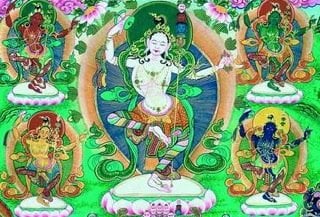
Practicing Dakinis
There are, it is said, countless emanations of wisdom, although at the ultimate level, they are all one. Probably the best known Dakini is Vajrayogini. These practices do require a teacher and initiation, due to their profundity, but many Buddhists around the world attend Tsog (as spectators and to receive blessings) and Dakini public pujas as a blessing. Padmasambhava described the Dakini as the “bestower of excellent blessings.” [3].
Dakini mantras should not be recited without appropriate teachings and intimations, although many people will get started on the path to feminine wisdom with the practices and mantras of Tara, which do not require initiation:
Om Tare Tuttare Ture Svaha
In addition, some Buddhists who may not yet have initiation, might set up a statue or tangkha of a Dakini, especially Vajrayogini, and present offerings. A student does not have to be initiated to honour the wisdom of Enlightenment. Initiation is a step towards realizing that Emptiness. But the precursor to that is often doing the things that Dakini’s delight in:
- Making offerings to all the Buddhas, Yidams and Dakinis, especially water offerings (a BW story on water offerings)>>
- Keeping vows and samaya with one’s teacher
- Taking Refuge in Guru, Buddha, Dharma Sangha (Guru and Three Precious Jewels.)
- Lamrim and foundation practices (a video on foundation and Lamrim practices here>>)
- Practice mindfulness and metta (loving kindness) meditation. Meditation is the path to wisdom. (Story on the ten benefits of Metta Loving Kindness Meditation here>>)
- Keep up your daily meditations and practice, and dedicate a little time to the contemplation of emptiness.
It is said that you do not have to call to Dakinis. Because we all have Buddha Nature, we all have Dakini within. Dakinis manifest spontaneously in our lives when we perform pleasing acts of compassion, conduct ourselves ethically, and follow the precepts.
Om Ah Hum.
NOTES
[3] Page 24 in “Dakini Teachings”
7 thoughts on “Tsog dates 2023: Happy Dakini Day — Introducing the Wisdom of the Female Enlightened Dakinis”
Leave a Comment
More articles by this author

Vajrayogini, enlightened wisdom queen, leads us to bliss, clear light and emptiness, despite modern obstacles

Padmasambhava Guru Rinpoche’s condensed “all teachings into one — which is concise and easy to practice”at the time of death: as requested by Lady Tsogyal

Wing Chun creator Buddhist Nun Ng Mui developed the art as a non-lethal martial art that mirrors six Buddhist Paramitas?
Search
Latest Features
Please support the "Spread the Dharma" mission as one of our heroic Dharma Supporting Members, or with a one-time donation.
Please Help Support the “Spread the Dharma” Mission!

Be a part of the noble mission as a supporting member or a patron, or a volunteer contributor of content.
The power of Dharma to help sentient beings, in part, lies in ensuring access to Buddha’s precious Dharma — the mission of Buddha Weekly. We can’t do it without you!
A non-profit association since 2007, Buddha Weekly published many feature articles, videos, and, podcasts. Please consider supporting the mission to preserve and “Spread the Dharma." Your support as either a patron or a supporting member helps defray the high costs of producing quality Dharma content. Thank you! Learn more here, or become one of our super karma heroes on Patreon.
Josephine Nolan
Author | Buddha Weekly
Josephine Nolan is an editor and contributing feature writer for several online publications, including EDI Weekly and Buddha Weekly.




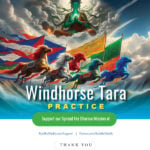






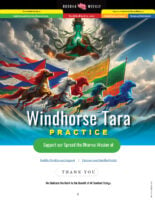
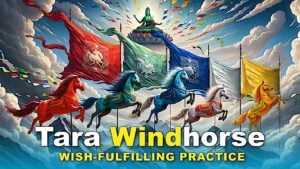



Please…want to be on email list…filled information…
Dear Karen, We’d be happy to add you. Our emails go out once a week (I believe Wednesdays). But it’s a “double opt in” type system for the protection of our readers, so normally you have to use our mini-form (just email really) on the site. Then, then send you an email which I think you have to approve to activate (that’s the protection part:-) The link to the form is: https://buddhaweekly.com/subscribe-to-weekly-email/
If you have no luck with the form, I can add you manually, but you’ll still receive a “verifying email” that you’ll have to click on to indicate you really want to be subscribed. (It’s the CSPAN rules:-) If you have no luck, please send me your email to editor@buddhaweekly.com.
Love This Webpage!
Many thanks Karen, our volunteer writers appreciate that! Much kindness, Metta, Lee
Thank you for this excellent magazine – one of the best Buddhist in the West 🙂 Namaste!
Thank you for your kind compliment! Namaste
Metta, Lee Kane
Such a pithy article, just the right amount of information needed for anyone getting started in Buddhism-Tantra. These nuanced aspects of practice is indeed the leverages that one needs further to realize enlightenment, and must therefore be taught (of course gradually) from the beginning. Much thanks 🙂